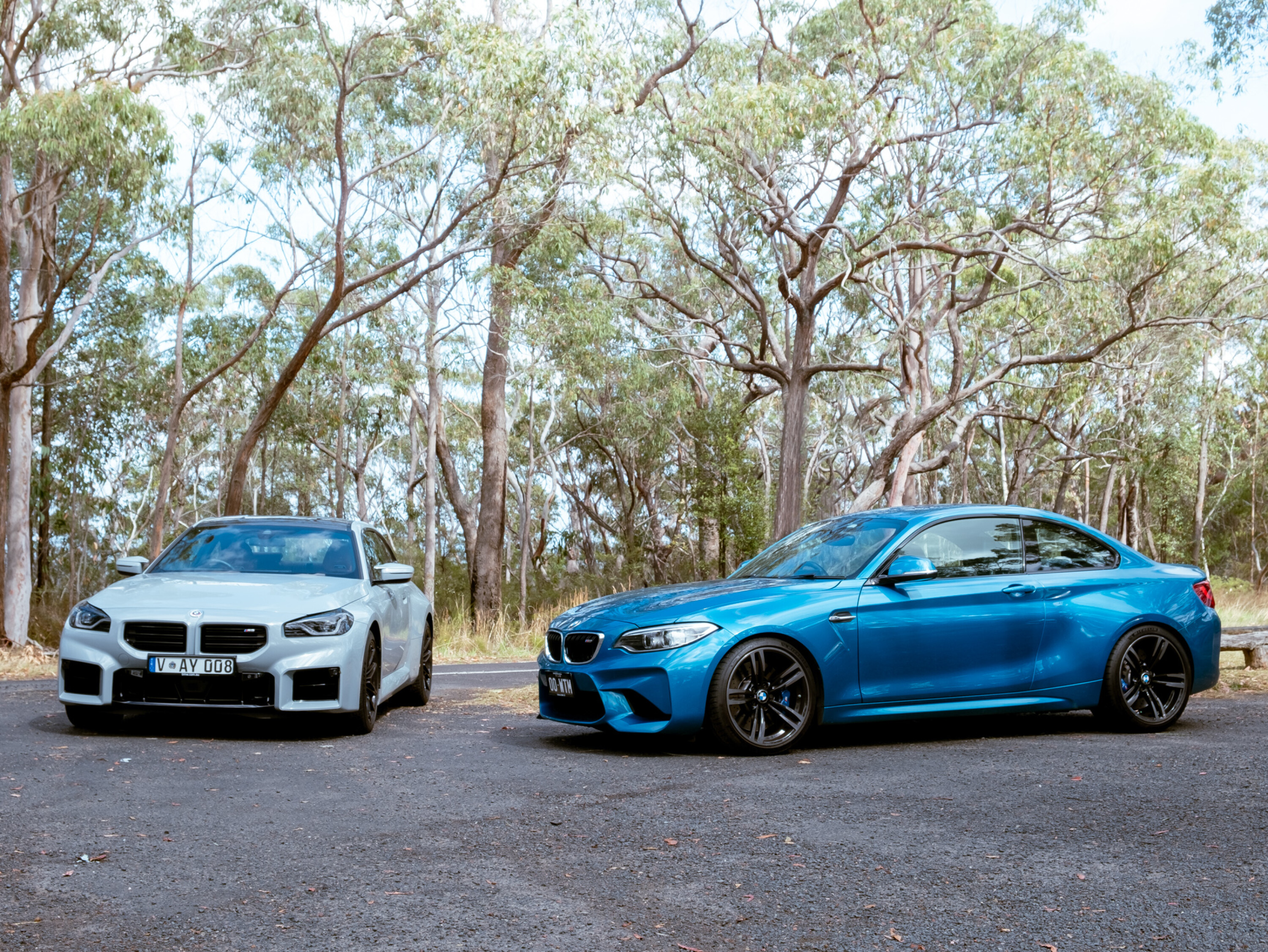The engineers at BMW M aren’t what you’d call lazy.
Ever since the M3 grew from svelte box-arched E30 into the executive express E36 in 1994, there have been skunkworks projects to capture the original compressed M Coupe’s magic.
I’m talking about the stillborn ‘M3 Compact [↗]’ in 1996 that came to pass in spirit as the limited 1M in 2011, a notoriously spiky baby M car built with the best bits from the M3 while the boss was on holiday. The 1M walked so the M2 could run, but even the relatively sanitised F87 had a whiff of after-work special about it – in a good way.
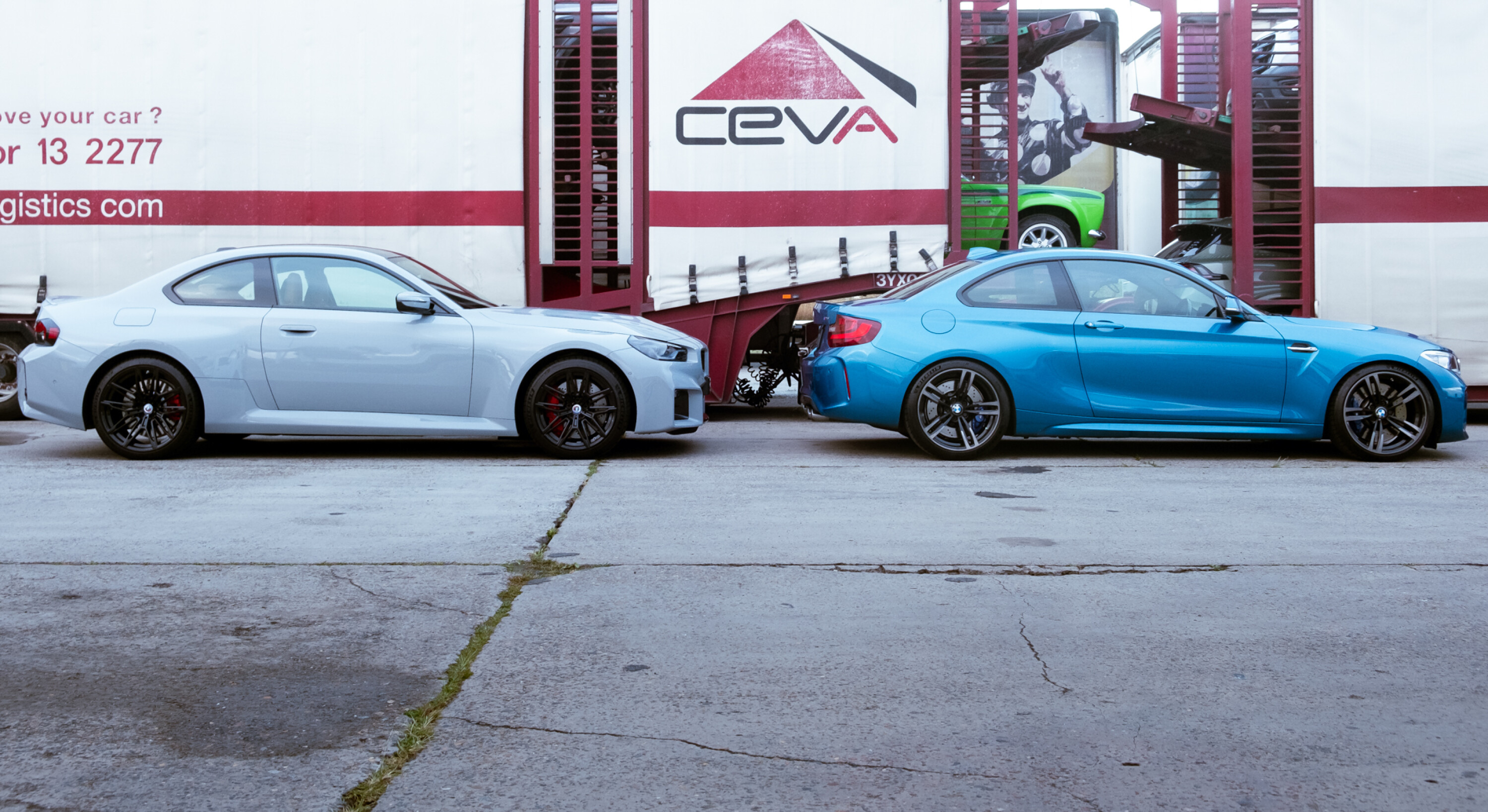
The new M2 is a proper M product. And I don’t mean it’s somehow more ‘M’ than its predecessors, rather, this is an M car designed to appeal to more people (and therefore make more money) than ever before.
BMW’s latest ‘G87’ is essentially a shrunken M4 and has grown in every dimension (bar height). Yet at its Australian launch, digital editor Inwood said he’d have one over the bigger coupe, describing its chassis as “grippy and positive, the body control taut and assertive”.
“The way it wants to rotate mid-corner so you can exploit the rear-drive balance is deeply satisfying,” he continued.
But is it better than the original? We’ve dragged a cooperative ‘OG’ M2 owner out to an excellent road to find out.
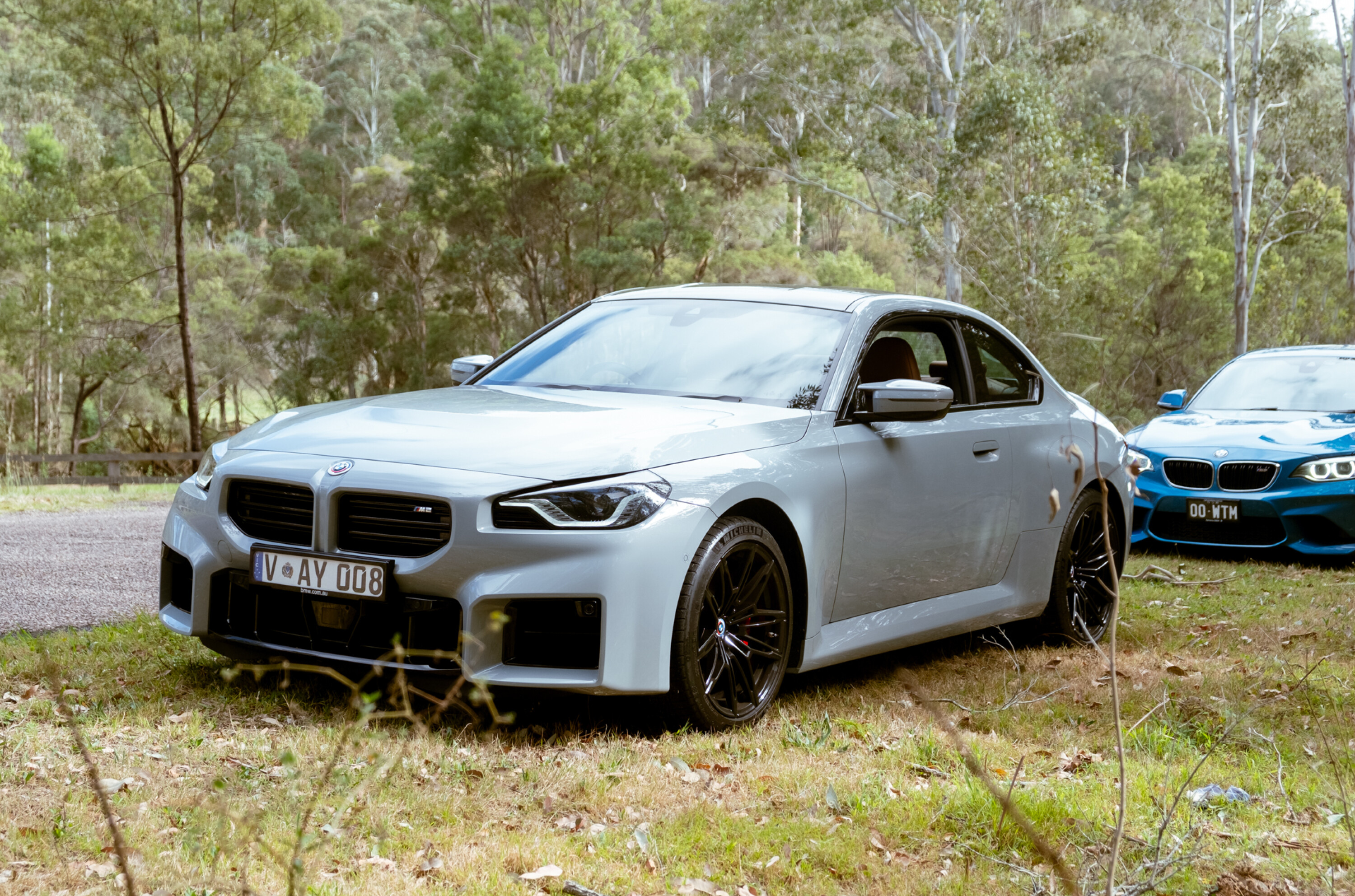
Note: Whose M2 is it anyway?
The 2017 M2 used in the comparison has been in one owner’s possession since new and boasts a full, up-to-date BMW service record. Four changes have been made to the original specification.
Apple CarPlay has been installed on the HMI, the original Michelin Pilot Super Sports are long dead and replaced by Pilot Sport 4S, and it has a metal charge pipe as a preventative measure.
It’s also fitted with M Performance coilovers. Manufactured by suspension specialists KW, the spring/damper package lowers the car by 10-15mm and adds 0.3º negative camber to the front axle. The high-quality dampers are more supple in their action and have improved rebound control, minimising the rear-end twitchiness for which the M2 was famous.
JUMP AHEAD
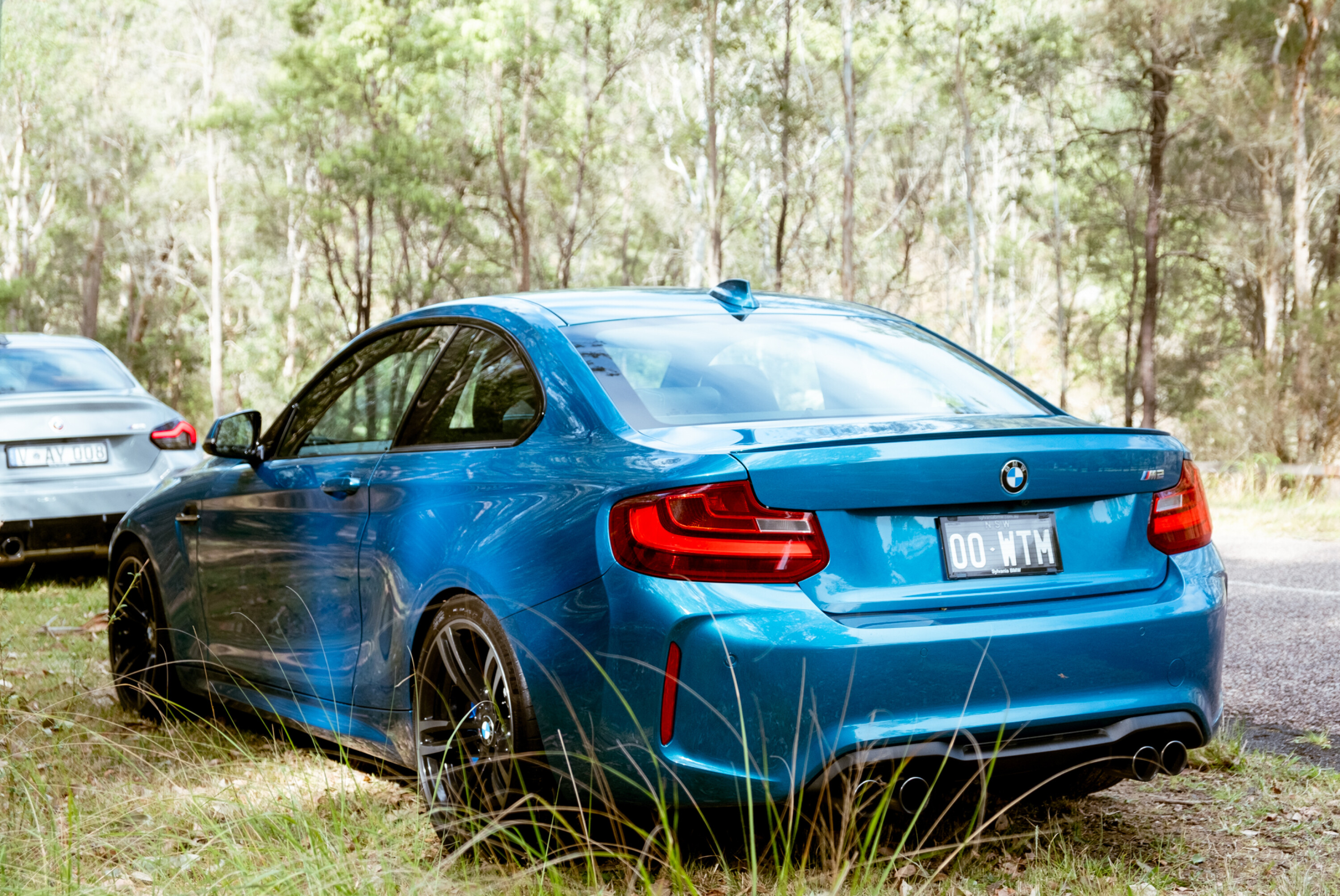
What do you get?
F87 M2
Representative of early M2s that were regarded as twitchy cars approaching the limit, we have a pre-LCI Pure manual.
It’s the cheapest M2 ever, listing for $90,500 before on-road costs when it was new. Second-hand prices now range from $60,000-$80,000, depending on condition.
Options were available and if you wanted to avoid the Pure’s positively povvo equipment list you had to tick them. This car – the driver’s pick – has manual adjust seats, no Apple CarPlay, unbranded audio, and analogue gauges.
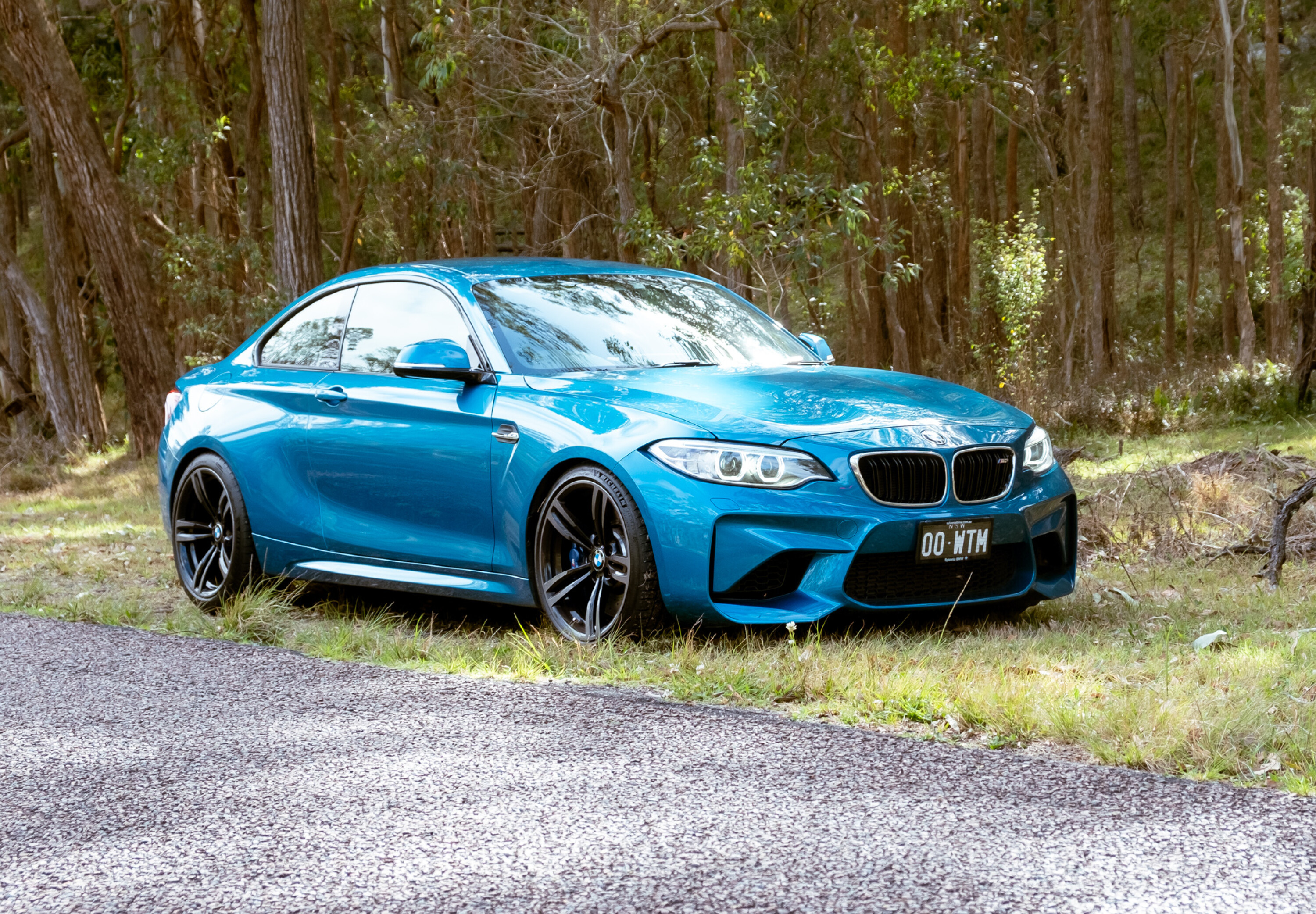
G87 M2
The new M2 is a totally different beast. Unlike the OG M2 that buyers could decontent to experience its unadulterated boy racer charm, the new car only builds on the M240i’s specification in Australia.
It has a massive curved 14.9-inch touchscreen, digital instruments, adaptive dampers, power seats with heating and a Harman Kardon sound system. Then we have the drive modes.
What can’t you configure in this new car? Everything from the exhaust note to the brake feel is now adjustable, whereas before it was just throttle response and ESC efficacy.
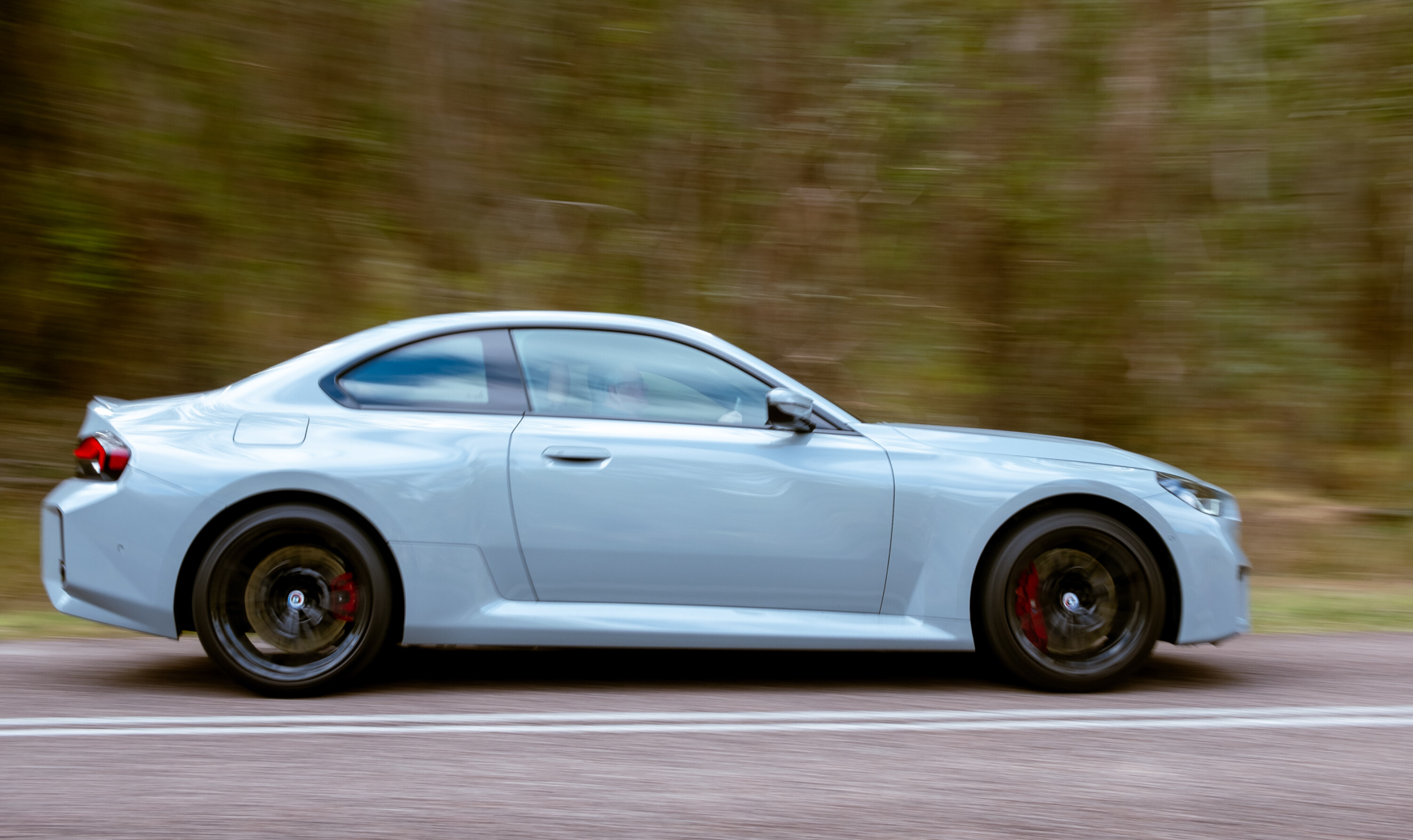
Dimensions
| Measurement | 2017 F87 M2 | 2023 G87 M2 |
|---|---|---|
| Length | 4468mm | 4580mm |
| Width | 1854mm | 1887mm |
| Height | 1410mm | 1403mm |
| Wheelbase | 2693mm | 2747mm |
| Track (F/R) | 1579/1601mm | 1617/1605mm |
| Kerb weight (DIN) | 1495kg | 1800kg |
Saying the new M2’s grown in every metric is misleading.
It’s significantly wider (the M240i is already as staunch as the OG M2), 112mm longer and rides on a wheelbase that’s been stretched by 54mm, yet its roofline falls by 7mm.
The resulting proportions are truer to the M2’s coupe position, with the older car presenting as a taller two-door sedan.
A lot has been said about the appearance of the G87 and much of that negative. Viewed from perpendicular angles at the right height, I’ll admit that the new car is stacked with presence. Thanks to the meaner proportions, it’s much better in real life than in photos.
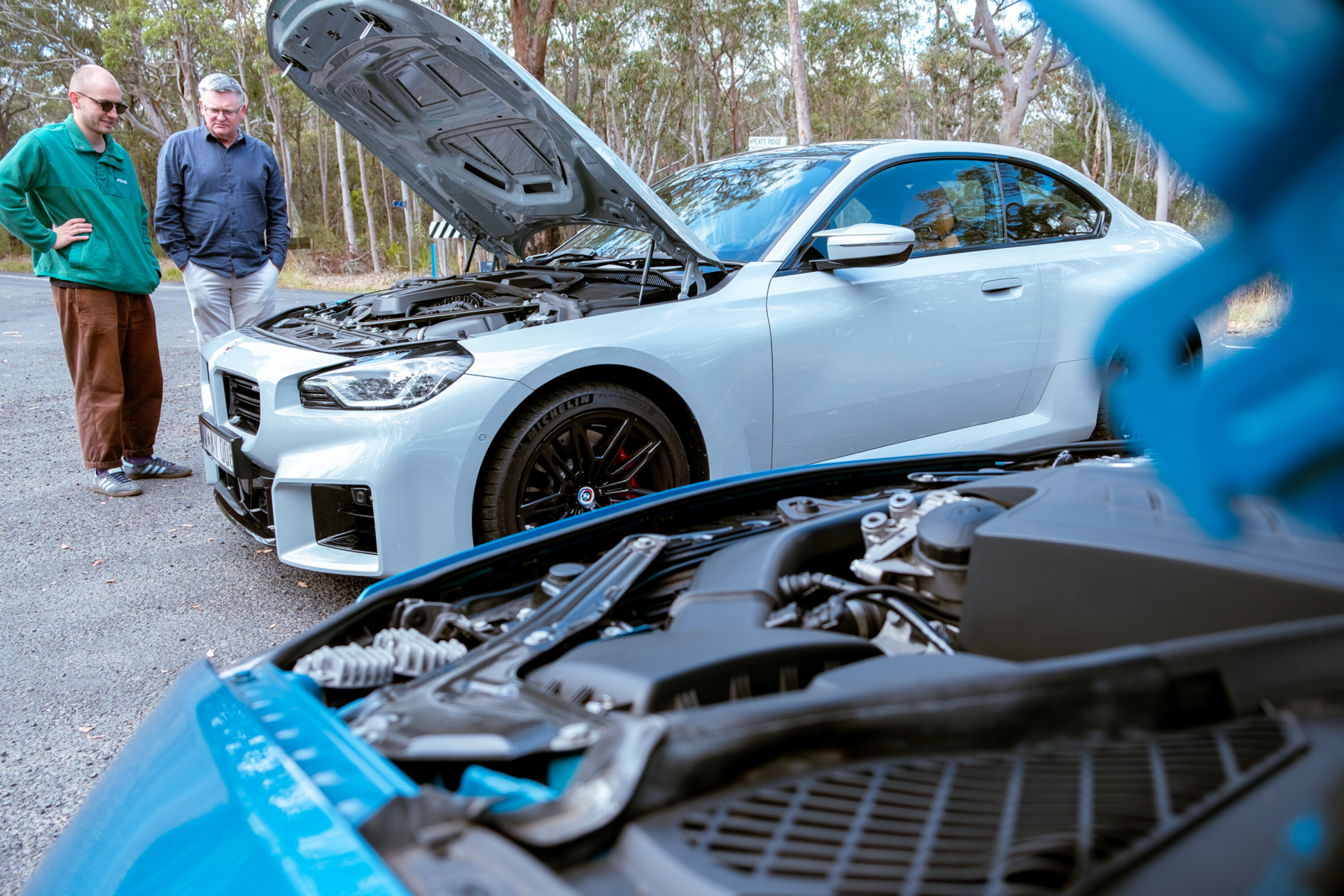
Following up a smash hit though? It’s nigh-on impossible. You’d never accuse the OG M2 of having Miura-rivalling looks, but it’s bloody eye-catching.
Every panel is blistered to perfection, the designers exercising restraint where it was needed. Perhaps 2016’s M Division favoured that money was spent on the oily bits rather than overcomplicated design.
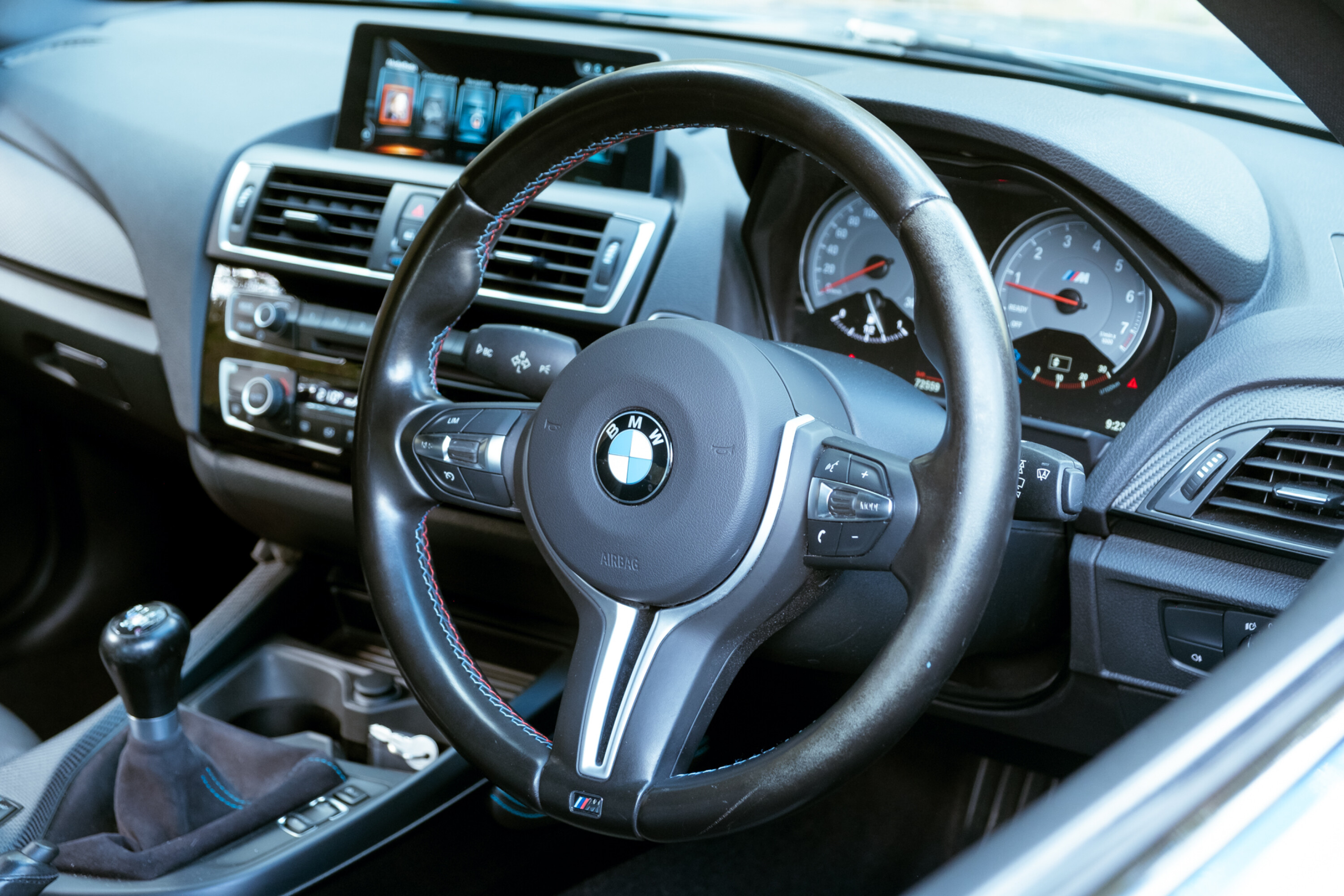

Interior space and practicality
Adding size hasn’t dramatically improved the M2’s cabin experience.
There may be more legroom in the back seats, yet the lower roofline of the new car means there’s precious little headroom for those over 160cm in the new car. Boot space is unchanged at 390L, too.
However, the front portion of the cabin does have more thoughtful storage, with bigger doorbins, more useful cup holders, a deeper central storage cubby and great seat adjustment. The new car’s lower roof gives a sportier view out with a narrow windscreen more in line with a Toyota Supra than a cooking 220i.

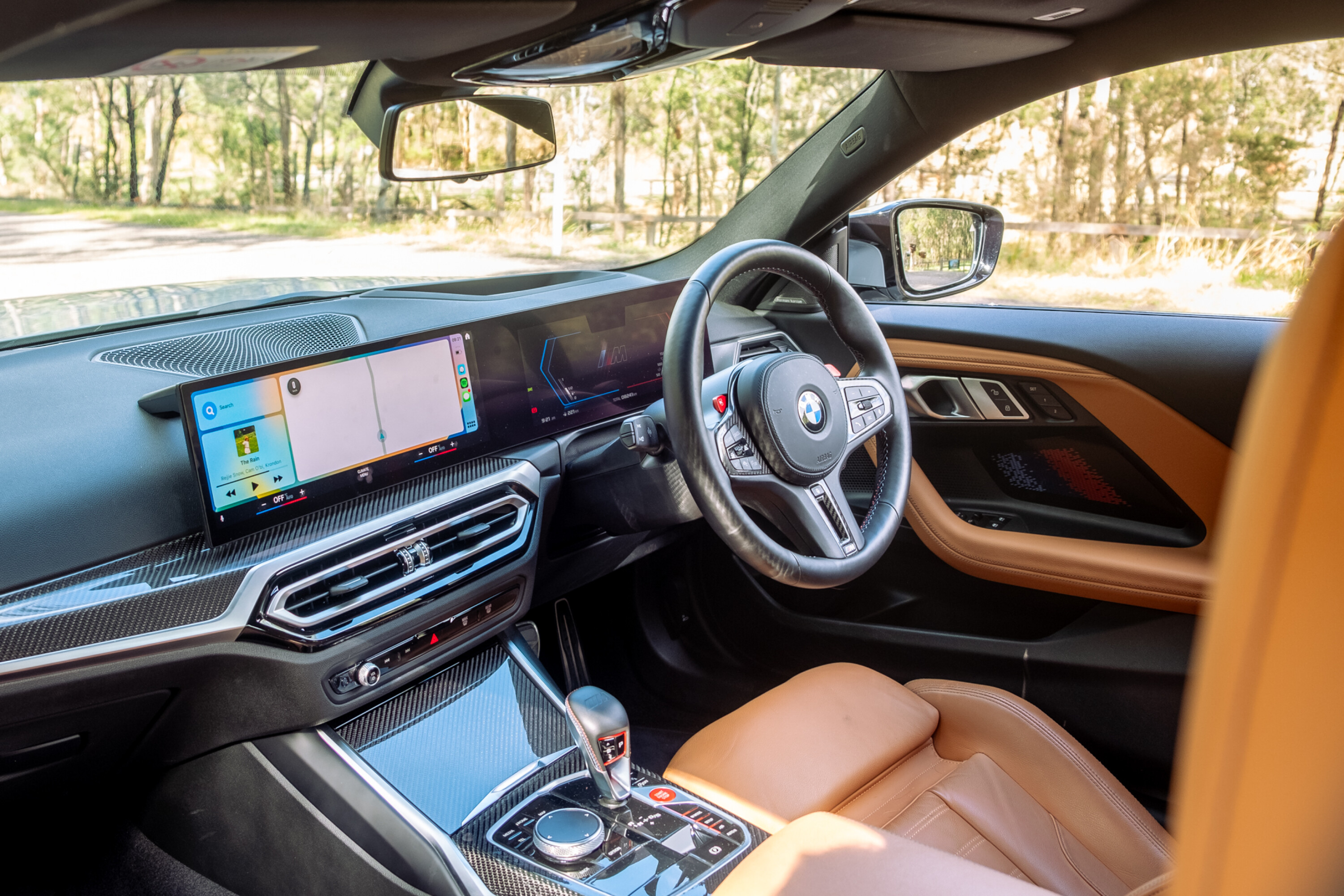
How do they drive?
F87 M2
One crucial factor that should tip the engagement in the old car’s favour is the manual gearshift.
Although never revered as being slick and mechanical like a Porsche shift, the long-throw lever in the F87 we have here seems to have opened up somewhat for a less notchy shift than when new.
That long throw also matches the control weights and feel of the F87 perfectly – it’s almost vintage in feel after the new car with such a long-travel throttle (even in Sport mode), clutch and brake pedal. Although not as instantly angry, it allows me to drive the unfamiliar F87 smoothly and with precision.
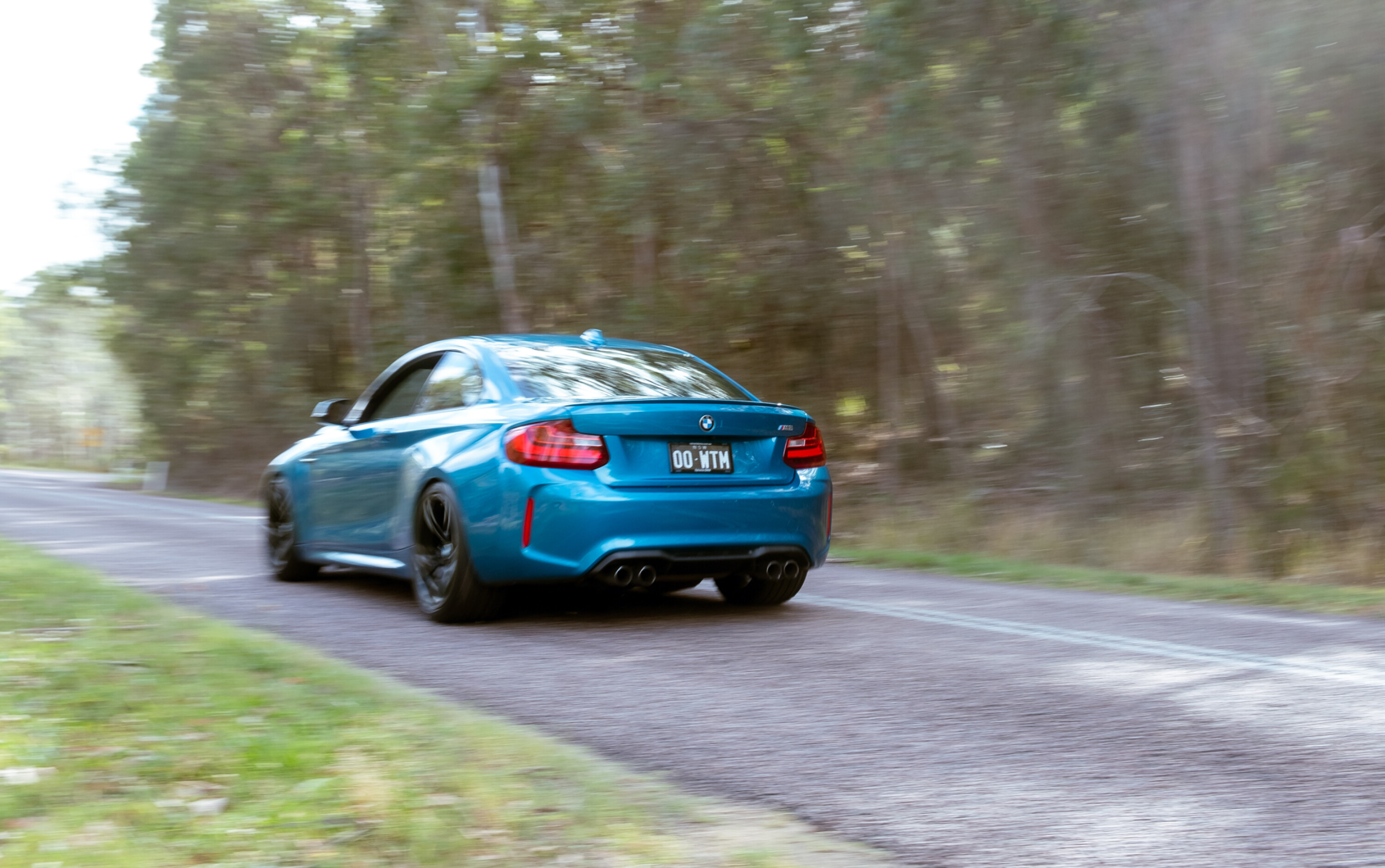
That higher seating position, more generous glass house and fewer screen-based drive mode distractions (there’s Sport, Sport Plus or ESC Off) add to its simple friendly charm.
Rolling into the powerband, the N55 (fettled by M in software and response, but not a full ‘M’ engine) is torquey and buttery.
It develops 272kW up at 6500rpm, giving reason to wind it out, but there’s a 465Nm dollop of torque spread between 1400-5560 rpm and little lag thanks to the twin-scroll turbocharger.
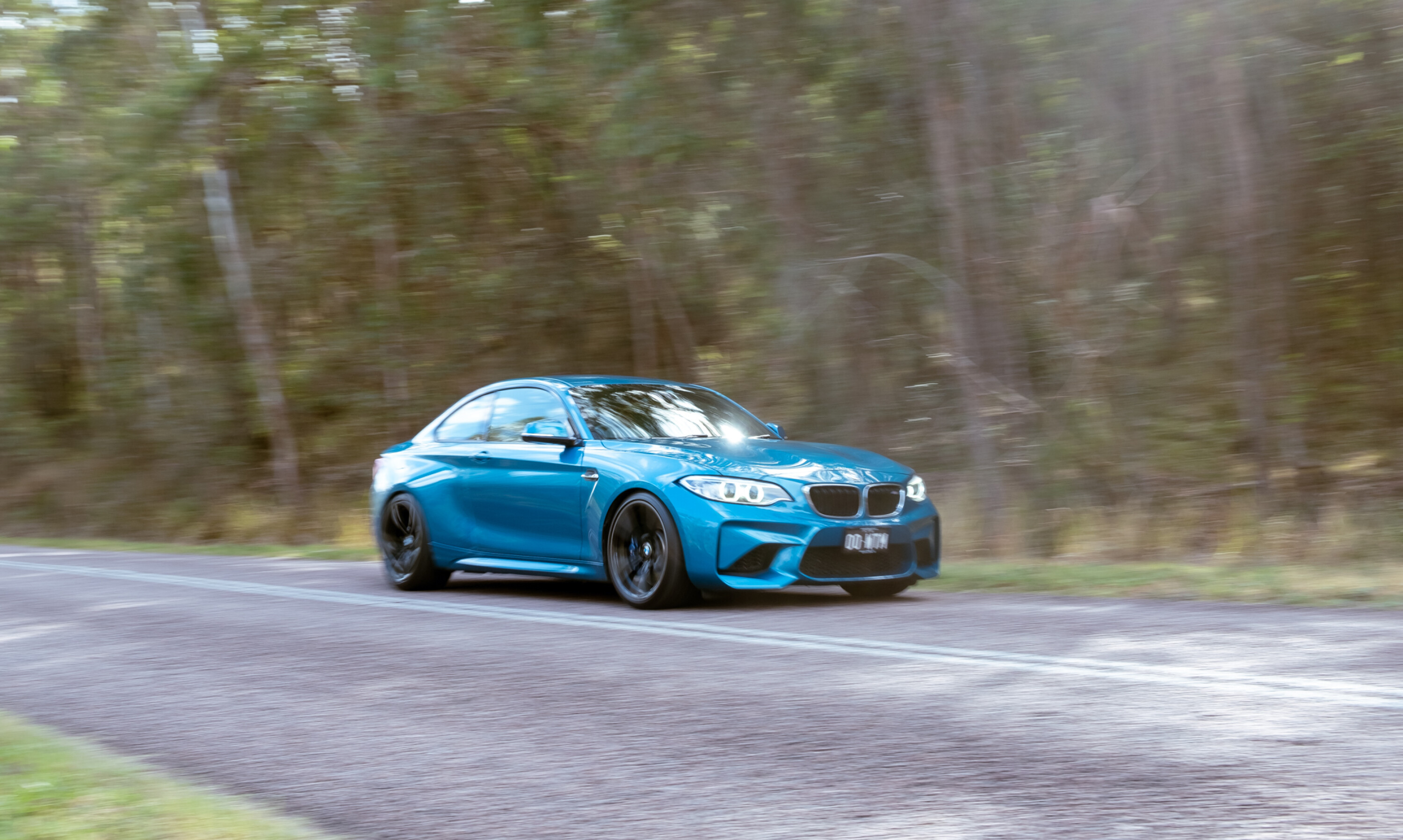
There’s some natural body roll that communicates grip levels and the M2’s playful balance
The amount of grunt feels well matched to the grip that the rear 265mm-wide (front 245mm) Michelin Pilot Sport 4S tyres have. Just enough to warrant care and deliberation when getting on throttle mid-corner – using a pedal that’s so easy to metre out accurately.
Beginning to push a little harder, I’m struck by how little stiction there is in the electronic power steering off-centre.
There’s some natural body roll that communicates grip levels and the M2’s playful balance. Although not as tenacious, this M2’s front end is somehow more trustworthy, though the brakes are definitely less inspiring than the new car’s.
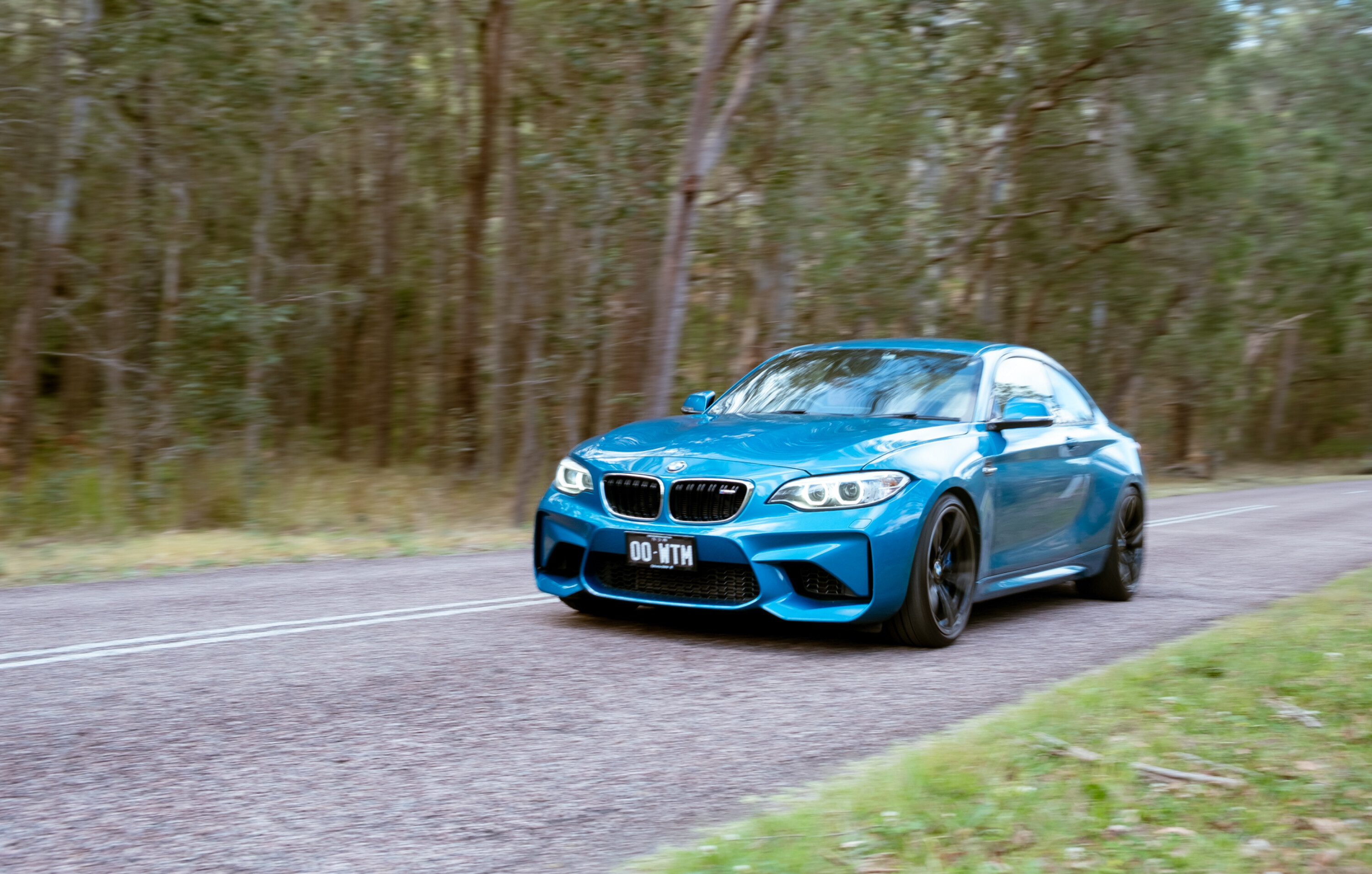
Having not driven this gen M2 much recently I’m struck by how intuitive it feels.
Blipping the throttle on downshifts, feeling the front end bite under brakes and playing with the rear end using throttle inputs is delightfully natural.
There’s also a greater envelope of operation in the old car, uncompromising ride notwithstanding. This M2 offers equal pleasure from slow speeds right through to maximum attack.
Being a manual aids this but so does the nuanced chassis. The F87 can be belligerent at times, if only because it’s the kind of mate who doesn’t want to leave the party.
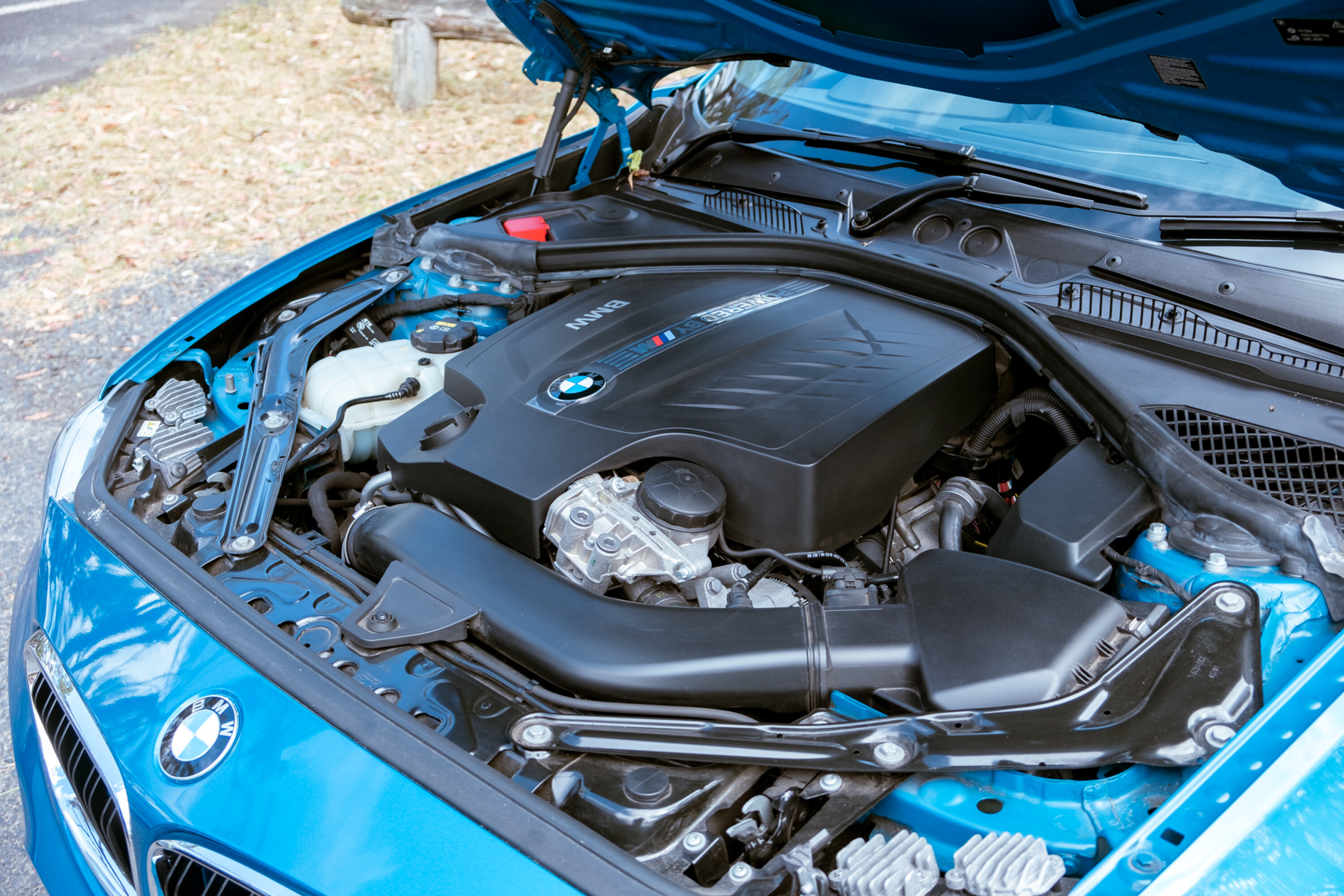
G87 M2
I struggle to suppress a laugh when I realise how much more accomplished the new M2 is at being a ‘normal’ car.
The effect is like turning on my headphones’ noise-cancelling on coarse-chip surfaces compared to the thunderous original. Even on its sophisticated ($5750 installed) M Performance coilovers, the old car simply can’t compete with the new car’s buttery smooth ride, either.
So it does the Dr Jekyll bit better. It’s also massively faster, something that the two-tenths improvement in 0-100km/h sprint (4.5 vs 4.3 seconds when both manual) entirely fails to communicate.
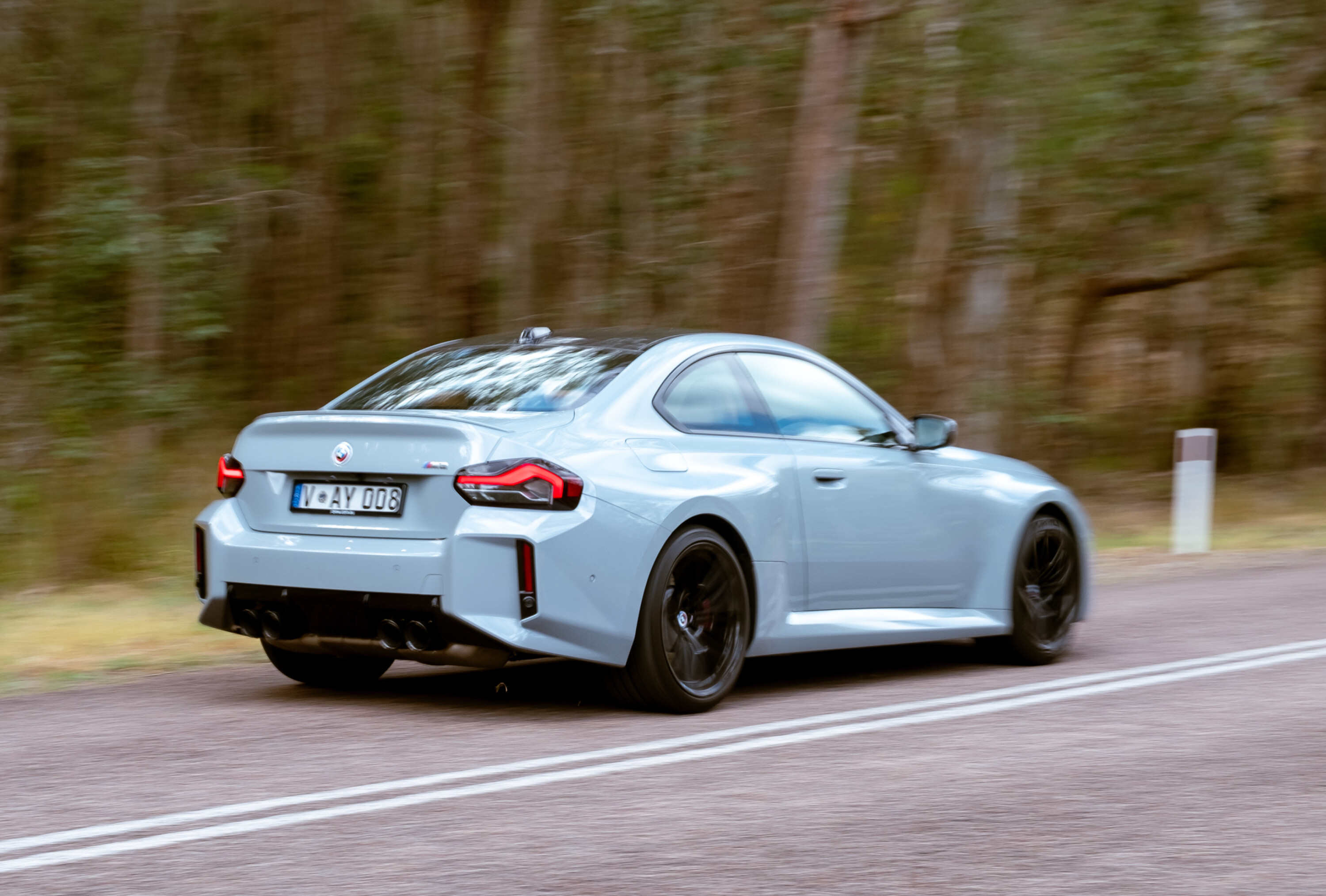
A metallic bark accompanies unstoppable power delivery from the 338kW/550Nm 3.0-litre twin-turbo S58. The eight-speed auto is ultra-smooth and plenty quick at shifting, if less theatrical than the old dual-clutch.
If you’re the kind of buyer after an angry-looking little coupe that’s devastatingly fast to do it all then read no further. Upgrading to the new car is the right call.
However, if you fell in love with the old M2 for its unashamed boy-racer excellence, the equation’s a little tougher.
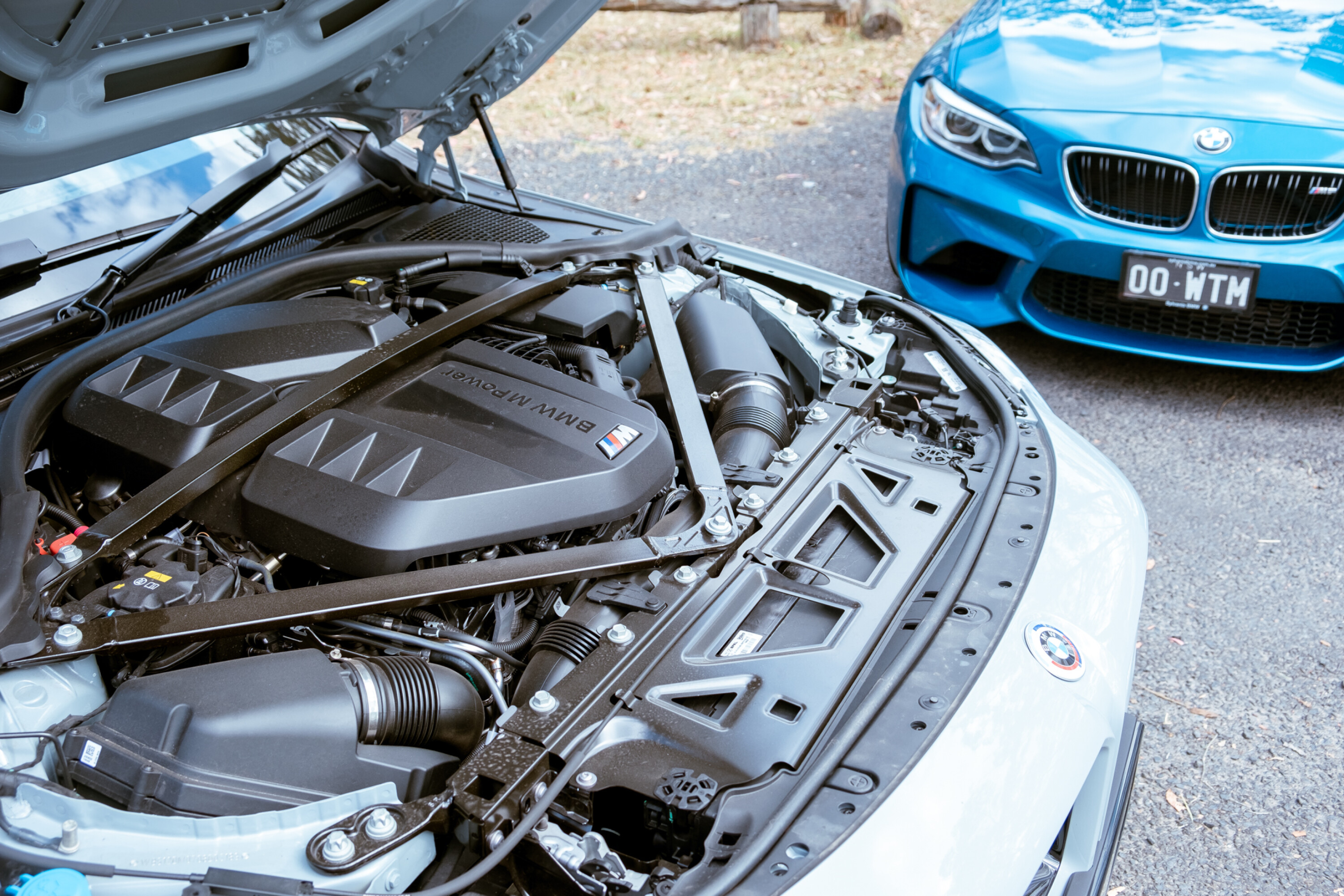
Its steering, for a start, is less natural with a dead zone around the straight ahead and a slightly elastic feel.
That elasticity continues in roll, where the new car resists body movements better initially, yet as those 1800kgs (300kg more than the old car!) overcome the springs and dampers it falls suddenly into the bump stops.
There’s also more front-rear pitch which, combined with a sharper throttle, makes it easier to generate understeer if you get on the power too early.
Luckily there’s prodigious power, torque and a more cleverly programmed M-Diff that, when in MDM mode, means you can nail the throttle after the apex and let the electronics do the work of deleting corner-exit understeer.
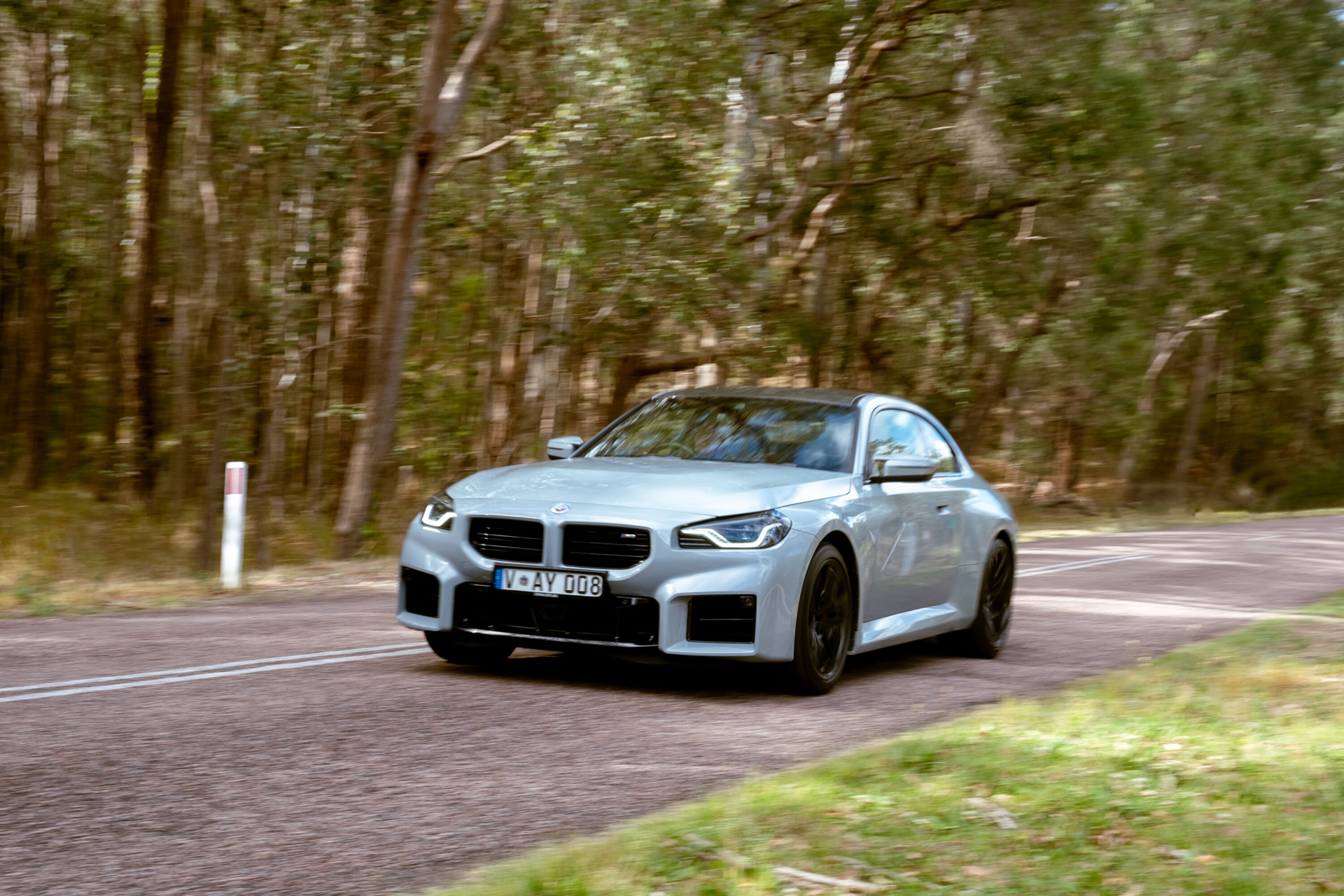
The new car is fast, fun, and flatters the driver.
Extra purchase from the wider front track and chubbier 275mm front/285mm rear star-marked Michelin Pilot Sport 4S rubber means it leaves the OG flailing in its dust for point-to-point pace.
The new M2 doesn’t shine at medium speeds, though. There isn’t as much malleability in the chassis, and the diff requires you to ask a lot of it for the new M2 to deliver joyous little oversteer moments. The weight figure, amazingly, doesn’t seem to dull its responses. It captures the M2 and 1M’s edgy baby M-car spirit – in fact, its at-limit lunacy levels are exaggerated.
Letu2019s talk settings u2699ufe0f
The old car’s pretty simple: Sport mode adjusts the steering, throttle, sound. The M Performance coilovers were set 10mm lower than factory with as-recommended compression resistance, and two (of 16 possible) clicks of extra rebound.
I refined the G87’s settings over several hours of driving. My ideal M1 had engine, dampers, steering and brake feel in Sport, transmission in S2, and dynamic stability control in MDM (or half-off) mode.
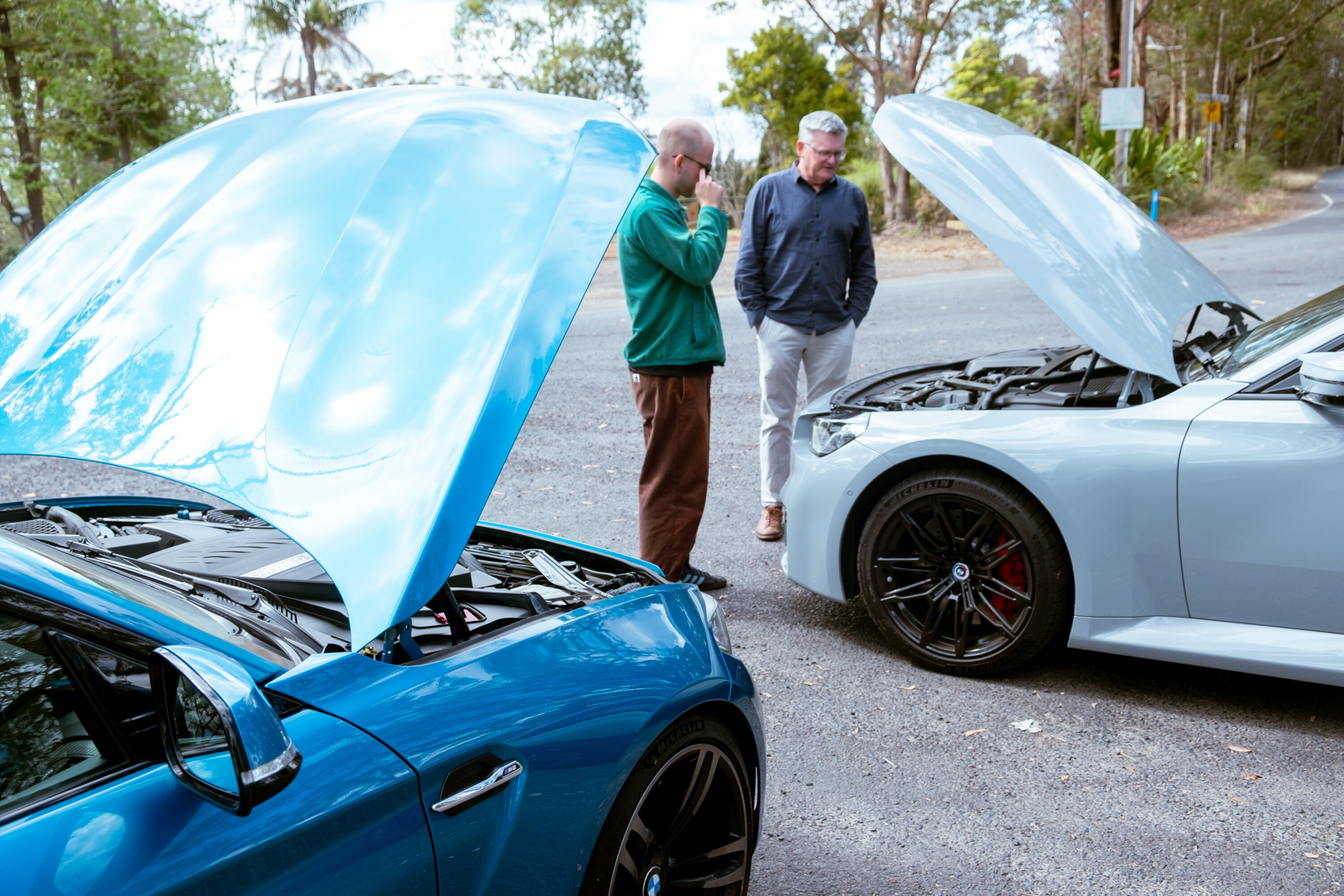
VERDICT: 2017 BMW M2 (F87)
For cult fans of this M2 and the 1M before who have second cars kicking around for daily duties, the F87 M2 – even better in angrier Competition or simply fabulous CS guise – is still the pick for sheer driving joy, communication and sense of occasion.
Things we like
- Perfect balance of grunt and grip
- Unashamed rear-driven balance
- Expertly matched control weights and travels
- Clear and unobstructed view out
Not so much…
- Missing an awful lot of creature comforts
- Ride is uncompromising
- Brake pedal could offer more confidence
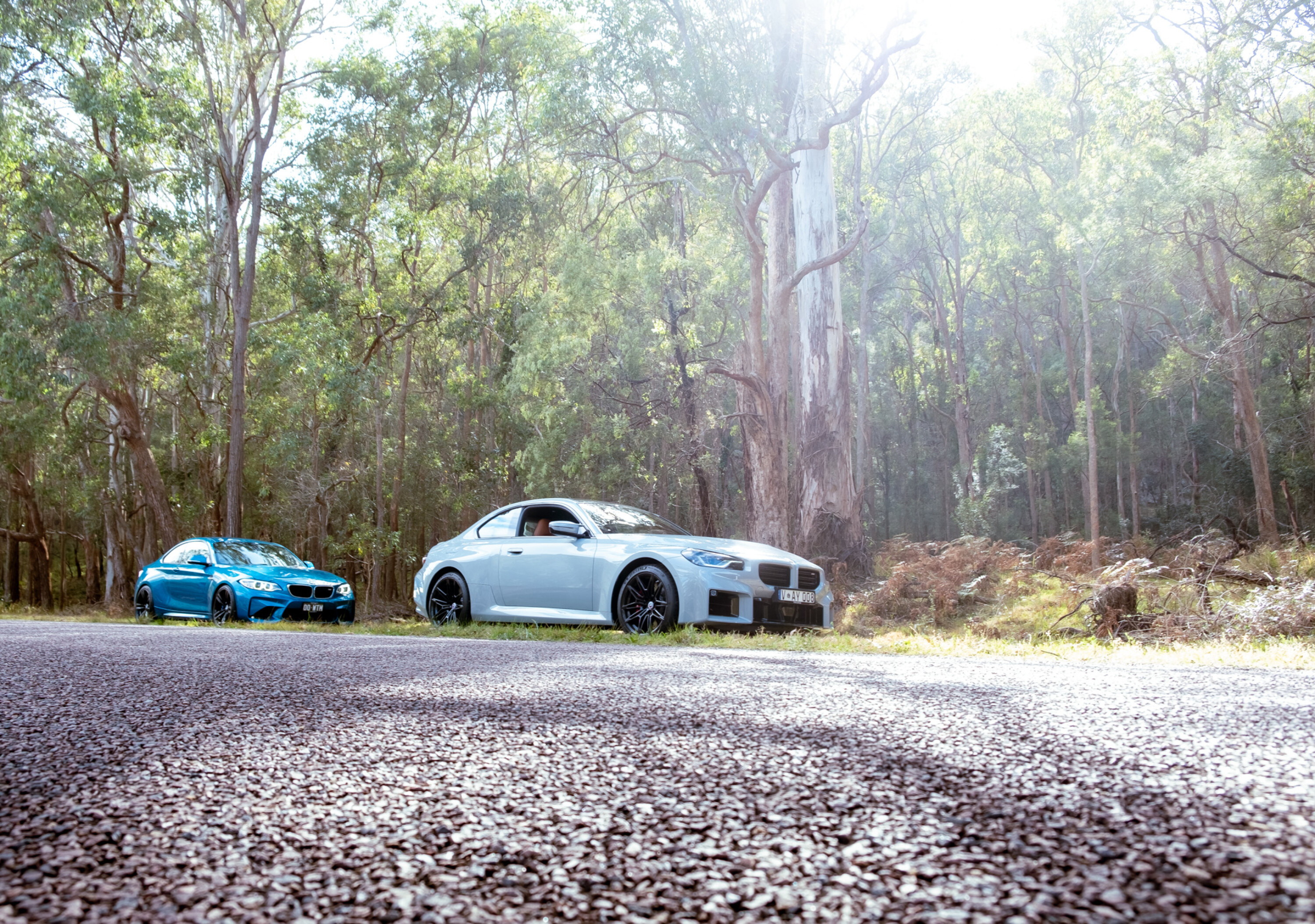
VERDICT: 2023 BMW M2 (G87)
The M2 has grown up, not old. It’s a distinct refinement of the breed.
A precious few (me included) will find that the original’s charming rough edges and jaw-dropping looks haven’t been replicated in HD clarity.
There are plenty of original M2 owners, though who will love this objectively better ball of energy’s added refinement, technology, comfort, speed and prodigious grip.
Things we like
- Bang up-to-date technology
- Soft and supple ride in Comfort
- Has lost none of the M2u2019s rear-drive lunacy
- Immensely fast and responsive
Not so much…
- An extra 300kg will accelerate consumable wear
- Back seat no more usable; boot the same
- No more rough edges means itu2019s lost some charm
We recommend
-
 Reviews
Reviews2023 BMW M2 review – Australian first drive
Another smash hit? Or a difficult second album? We deliver the verdict on BMW M’s smallest model
-
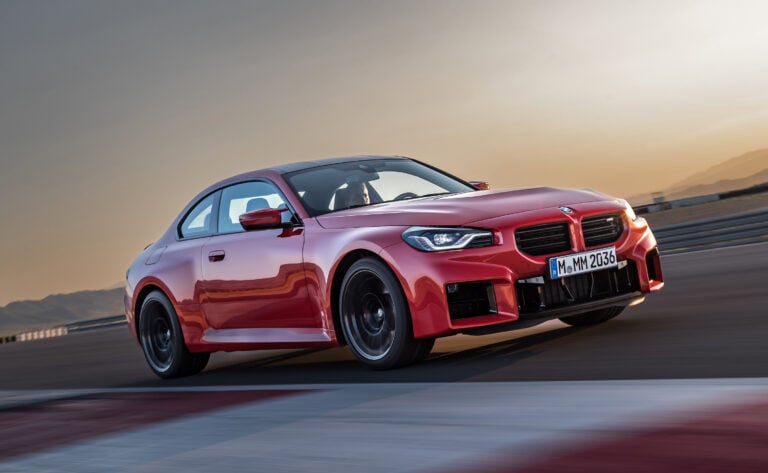 News
News2023 BMW M2: Australian pricing and design review
BMW Australia has confirmed the price tag of its second-generation hero sports coupe.
-
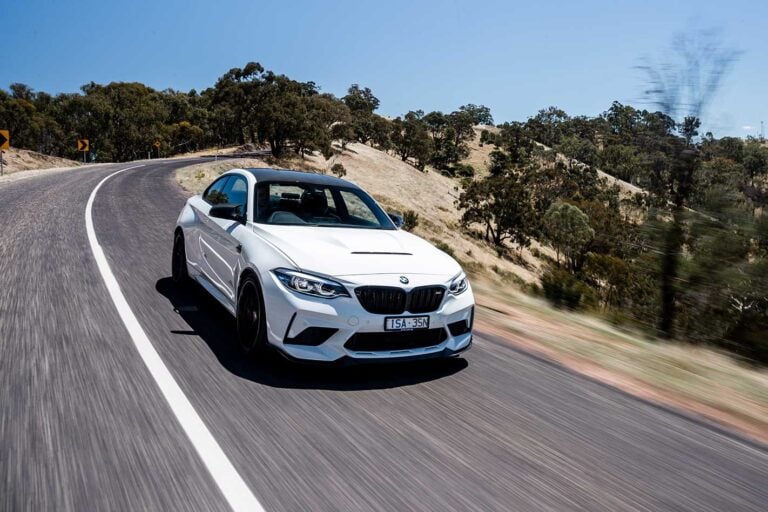 Reviews
Reviews2021 BMW M2 CS manual review
Flagship 2 Series is one of BMW’s finest driving machines


